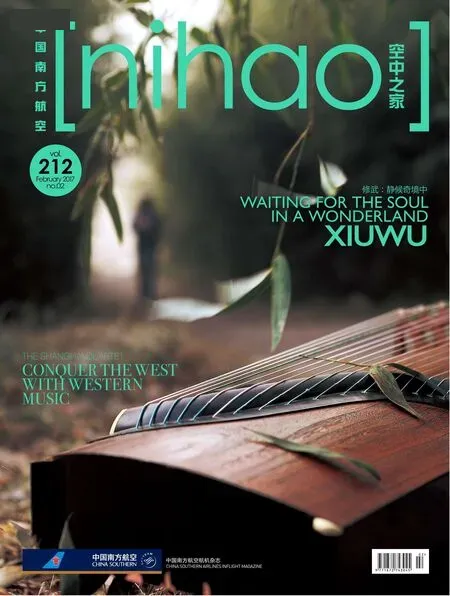Minnan steaming hot fried rice noodles in the Philippines
Text by Wong, Fisher Hung-yue Translation by Bian Jiajin Photos by IC & CFP
Minnan steaming hot fried rice noodles in the Philippines
Text by Wong, Fisher Hung-yue Translation by Bian Jiajin Photos by IC & CFP

Wong, Fisher Hung-yue
Assistant to the Publisher Chinese Commercial News, Philippines. Bachelor of Arts in Journalism The University of Georgia, U.S.A. Born: Jinjiang, Fujian, China.
作者:王鸿瑜
菲律宾《商报》社长助理美国佐治亚大学新闻系文学士
祖籍: 中国福建晋江

Before Zheng He's Treasure Voyages, the Minnan people from Quanzhou, Fujian, had already crossed the Taiwan Strait to Lvsong Island to run all kinds of businesses.
The Philippines has a fertile land full of rice. The diligent Minnan people dry the rice noodles alongside the fields, produce them in large amounts and supply the karinderya snack stands continuously. The steaming hot fried hometown rice noodles are cheap, delicious, and always sell well.
For hundreds of years, Bihon Guisado has been flourishing with different kinds of ways of cooking created by different nations in the Philippines. This transformed karinderya from snack stands on the streets to luxurious restaurants and grand hotels. Now, from the northernmost Apari to the southernmost Tawi Tawi in the Philippines, people can eat these typical and pure fried rice noodles at any time. What's worth noting is that in the Philippines, in any Chinese commercial district, Minnan dialect is also universal.
On the vivid and picturesque menu of the Max Restaurant, which has over 100 chain restaurants and was established in 1945 by Spanish Filipinos, the Minnan snacks such as Pancit Bihou, Lumping Ubod, and Lomi are all listed, which is also proof of the cultural influence of the Minnan people.
In the 1980s, a boy called Tony Tankaitiong, who came from Jinjiang, Fuijan, opened an American burger fastfood store in the Chinese community in Manila. In order to attract more local customers, he refined and concentrated the Philippines style fried rice noodles, Palabok. Then his new fastfood restaurant Jollibee exploded in popularity. Chen not only kept improving, but also started to accept new investors and adopted the western methods of management. Jollibee has been developing for over 30 years, and now it has over a thousand stores in the whole of the Philippines. The chain stores are now also spotted in Hong Kong, Singapore, Brunei, California and Canada. In the recent years, the stock of JOLLIBEE has rocketed, which makes Chen Juezhong one of the richest people in the Philippines.
The Minnan fried rice noodles are still popular in the Philippines, and still make a fortune for people.

菲律宾的闽南米粉
三宝太监下西洋之前,福建泉州一带的闽南人早已乘船过“大沟”(是指现在的台湾海峡)飘海到吕宋岛谋生,经营各式各类的行业。应地而生的“卡兰”小吃店(菲名:karinderya)更是遍布每条街道。
菲律宾土地肥沃,米稻充盛,勤劳的闽南人在田边晒起米粉,大量生产,成品源源不断供应“卡兰”小吃店,热腾腾的家乡炒米粉价廉美味深受大众欢迎。
数百年来,炒米粉(菲名: Bihon Guisado)在菲律宾不同民族不同烹饪方式下百花齐放,也由路边“卡兰”小吃店走进高级餐馆以及五星大酒店。现在,由菲律宾最北的阿巴里(Apari)到最南的达威达威(Tawi Tawi),随时可以吃到地道的炒米粉。值得一提的是,菲律宾由北至南,华人商业区,至今全部可以用闽南话沟通。
由西班牙裔菲律宾人于1945年创办的数百间连锁餐馆 Max Restaurant 精致图文并茂的餐牌菜单上,炒米粉(菲名:Pancit Bihon),润饼(菲名:Lumpiang Ubod),卤面(菲名:Lomi)等闽南小吃均列其中,闽南人的文化影响印证一切。
上世纪80年代,一个名为陈觉中的福建晋江小伙子在马尼拉市华人区开了一间美式汉堡快餐店,为了吸引本地食客,他把菲式米粉“巴拉博”(Palabok)精巧化,浓缩化,结果他的“快乐蜂”快餐店(JOLLIBEE) 一炮而红。30多年后,现有逾千间“快乐蜂”餐店遍布全菲,中国香港、新加坡、文莱、美国加州、加拿大等地均有分店,陈觉中也晋身菲国富豪行列。
闽南炒米粉持续在菲律宾热卖,继续在为人民创造财富。

